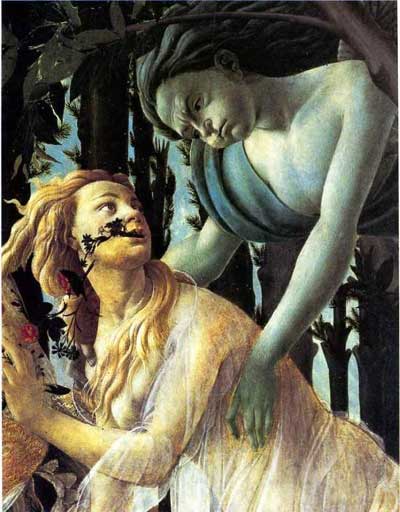


“Birth of Venus” and “Primavera” Are two of my favorite paintings, created by Sandro Botticelli.
Botticelli’s style of painting included balance, weight, and seldom distribution of volume in his figures. The way Venus is drawn is illusory; the weight shifted on her right side would make it impossible for her to not tip over. Venus is shown standing in a classical contrapposto stance. A contrapposto stance is when a figure typically holds the weight of the body on one leg, and has the other leg relaxed. Having the shoulders and hips of the figure adjusting in opposite angles, giving the torso the shape of an “S”; this unnatural style of painting, can be compared to Venus’s left arm, face and neck that is attached to her body. One of the wonderful things about “The Birth of Venus” is how the background is clear, with no casting shadows; the elegance of the background gives us the image of fantasy! The gorgeous draperies of the nymph, the bright yet soothing colors, and nude Venus bring the audience a pleasurable view.
“Primavera”, another great tempera panel painting represents the celebration of spring! This work of art is known to be “One of the most popular paintings in Western art.”What inspires me most about this tempera panel painting is the allegorical theme behind this controversial painting. Underneath the orange grove we have the goddess Venus in the centre, to the left of Venus we see the goddess of flowers, Flora. The amazing transformation of the nymph Chloris into Flora is magnificent! Botticelli depicts natural facial expressions of Chloris as she is seized by the God of Wind, her transformation begins to trickle from her face down. The floral print is painted from her mouth outward. An interesting fact about the flowers incorporated in this painting is that, this scene has 500 identified plant species depicted in the painting, with about 190 different flowers (Botticelli, 2002).
Both artworks show balance in harmony, allegorical and mythical themes, and represent the Greek goddess of love in two different ways.
“Primavera”, another great tempera panel painting represents the celebration of spring! This work of art is known to be “One of the most popular paintings in Western art.”What inspires me most about this tempera panel painting is the allegorical theme behind this controversial painting. Underneath the orange grove we have the goddess Venus in the centre, to the left of Venus we see the goddess of flowers, Flora. The amazing transformation of the nymph Chloris into Flora is magnificent! Botticelli depicts natural facial expressions of Chloris as she is seized by the God of Wind, her transformation begins to trickle from her face down. The floral print is painted from her mouth outward. An interesting fact about the flowers incorporated in this painting is that, this scene has 500 identified plant species depicted in the painting, with about 190 different flowers (Botticelli, 2002).
Both artworks show balance in harmony, allegorical and mythical themes, and represent the Greek goddess of love in two different ways.
-Sheena John
No comments:
Post a Comment